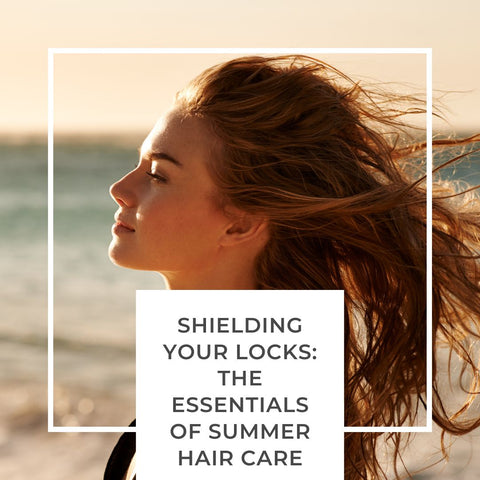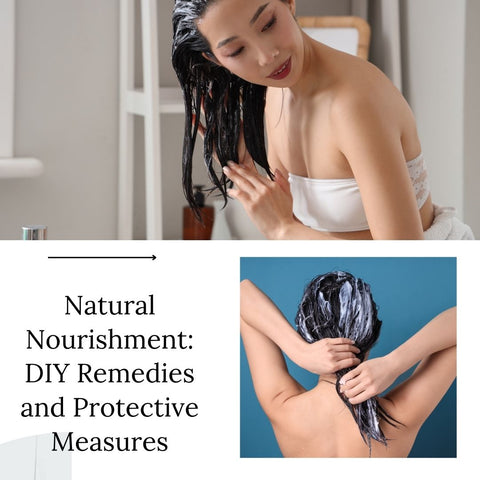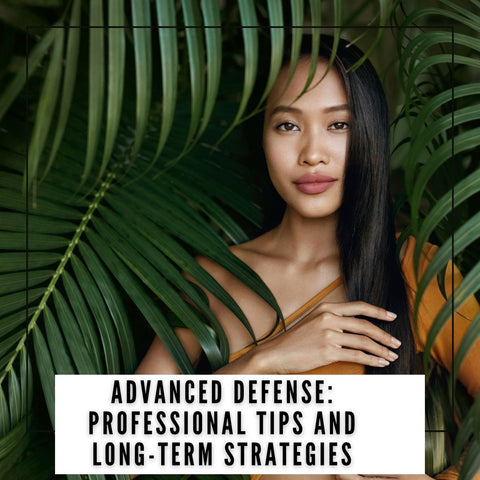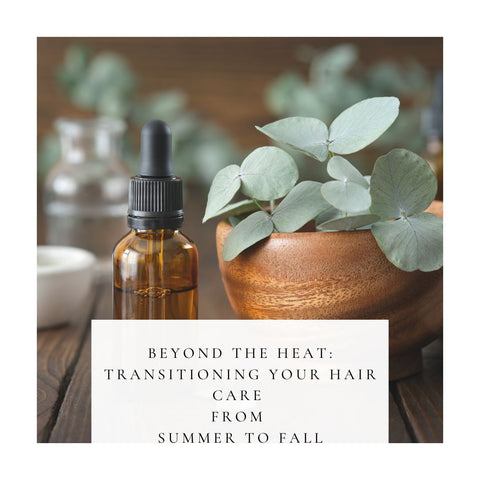Summer can be difficult on your hair, with sun exposure, humidity, and chlorine from swimming pools all posing issues. In this blog, we'll look at 11 essential summer hair care tips for protecting your locks and keeping them healthy and vibrant.
Shielding Your Locks: The Essentials of Summer Hair Care

Protecting your hair from the harsh summer elements is essential for keeping it healthy and vibrant. Sun protection, moisture locking, chlorine defence, UV protection, heat styling limitation, gentle detangling, protective hairstyles, regular trims, deep conditioning treatments, scalp care, and hydrating mists are the most important summer hair care essentials. By incorporating these essential summer hair care tips into your daily routine, you can protect your locks from the sun, heat, and other environmental stressors, keeping them healthy, vibrant, and protected all summer.
Understanding UV Impact: Protecting Hair at the Molecular Level
Understanding how UV radiation affects the structure of your hair and putting mitigation techniques into practice are essential to molecularly protecting it. Here's how to prevent UV damage to your hair:
-
UV Radiation Effects: UV rays cause structural alterations in hair, including protein degradation, moisture loss, and colour fading, by penetrating the cuticle. Long-term UV exposure weakens the hair shaft, increasing the risk of split ends, breakage, and dullness in general.
-
UV Filters in Hair Products: Look for UV-protective hair products containing benzophenone-4 or octyl methoxycinnamate. These ingredients create a protective layer on the hair's surface, absorbing and scattering UV rays to reduce damage.
-
Leave-In UV Protectants: Use UV-filtering leave-in conditioners or serums to provide all-day UV protection. These products can help maintain hair health and prevent colour fading, particularly in color-treated hair.
-
Protective Hairstyles: Wear protective hairstyles such as braids, buns, or hats to shield your hair from direct sunlight. This reduces UV exposure and helps to maintain hair integrity, especially during prolonged outdoor activities.
-
Natural UV Protection: Some natural oils, such as coconut and avocado oil, have inherent UV protection properties. Applying these oils to your hair can add another layer of protection against UV rays while also nourishing and moisturising it.
-
Limiting Sun Exposure: Minimize direct sun exposure during peak UV hours, typically between 10 AM and 4 PM. If you spend a lot of time outside, seek shade or cover your hair with a scarf or hat for extra protection.
-
Hydration and Moisture: Keep your hair hydrated and moisturised to help it withstand UV damage. Use hydrating shampoos and conditioners, and include weekly deep conditioning treatments to replenish moisture and repair damage.
-
Regular Trimming: Schedule regular hair trims to remove split ends and prevent further damage to the hair shaft. Trimming promotes hair health and reduces the likelihood of breakage due to UV exposure.
-
Post-Sun Care: After sun exposure, rinse your hair with cool water to remove any saltwater or chlorine residue that may exacerbate UV damage. To rehydrate and nourish your hair, apply a moisturising conditioner or hair mask.
-
Scalp Protection: Wearing a hat or applying sunscreen to exposed areas will help protect your scalp from UV radiation. A healthy scalp promotes healthy hair growth and reduces the risk of sunburn and damage.
You can protect your hair from harm and keep it healthy, strong, and vibrant—even in the summer—by learning how UV radiation affects hair molecules and putting preventative measures in place.
Hydration Heroes: Products and Practices for Moisturizing Sun-Kissed Hair
Your hair care regimen must include hydrating products and practices to keep sun-kissed hair hydrated and healthy. The following hydration icons can help moisturise sun-kissed hair:
-
Apply hydrating shampoo and conditioner made especially to restore moisture and nourish hair that has been exposed to the sun. To hydrate and revitalise your hair, look for products with ingredients like hyaluronic acid, coconut oil, or shea butter.
-
To repair and moisturise sun-damaged strands, treat your hair to weekly deep conditioning treatments. Choose a rich, nourishing hair mask or treatment containing ingredients like argan oil, avocado oil, or keratin to restore moisture and strengthen your hair.
-
Incorporate a leave-in conditioner into your hair care routine to maintain hydration and protection throughout the day. Look for lightweight formulas that will not weigh down your hair, and apply them to damp or dry hair to seal in moisture and prevent dryness and frizz.
-
Use hair oils to moisturize and nourish sun-kissed hair, particularly the ends, which are drier and more vulnerable to damage. Choose lightweight oils such as argan oil, jojoba oil, or marula oil and apply a small amount to damp or dry hair to add shine and moisture.
-
Coconut water spray refreshes and hydrates sun-kissed hair. Coconut water contains electrolytes and vitamins that help hydrate and revitalise hair, making it soft, shiny, and manageable. Spritz it on damp or dry hair whenever you need to add moisture.
-
Apply a hydrating hair mask once or twice a week to deeply moisturise and repair sun-damaged strands. Look for masks containing ingredients like honey, aloe vera, or glycerin to hydrate, nourish, and rejuvenate your hair from root to tip.
-
Wear protective hairstyles such as braids, buns, or twists to protect your hair from the sun and prevent moisture loss. These styles protect your hair from environmental stressors while keeping it hydrated and healthy.
-
Rinse your hair with cool water after swimming or spending time in the sun to remove saltwater or chlorine residue and seal the hair cuticle. This helps to seal in moisture and prevents additional damage from environmental factors.
-
To prevent further moisture loss and damage to sun-kissed hair, avoid using heat styling and instead air-dry it whenever possible. If you must use heat tools, use a heat protectant spray or serum to keep your hair safe from heat damage.
-
Do not forget to hydrate your scalp; a healthy scalp is essential for keeping your hair hydrated. Use scalp treatments with hydrating ingredients like hyaluronic acid or tea tree oil to moisturise and soothe your scalp while encouraging healthy hair growth.
Style and Substance: Chic Hairstyles That Also Protect Your Hair
Chic hairstyles that protect your hair are ideal for keeping it healthy and stylish. Braided Crown, Low Bun with Scarf, Twisted Updo, Box Braids, High Ponytail with Scrunchie, Messy Bun with Bobby Pins, Fishtail Braid, Low Ponytail with Hair Wrap, Twist-Out, and Half-Up Top Knot are some popular and protective hairstyles to consider.
Natural Nourishment: DIY Remedies and Protective Measures

DIY remedies and protective measures provide natural nourishment and protection for your hair, promoting its health and vitality. Here are some useful DIY treatments and practices to consider:
-
Coconut Oil Hair Mask: Coconut oil contains fatty acids that penetrate the hair shaft, moisturising and nourishing it from within. Apply warm coconut oil to your hair, focusing on the ends, and let it sit for at least 30 minutes before shampooing. This DIY hair mask restores moisture and strength to sun-damaged hair.
-
Apple Cider Vinegar Rinse: An apple cider vinegar rinse helps to remove buildup from the scalp and hair, restoring pH balance and increasing shine. Combine one part apple cider vinegar with three parts water and use as a final rinse after shampooing. This homemade remedy cleanses the hair and scalp, leaving them feeling refreshed and revitalised.
-
Aloe Vera Gel Scalp Treatment: Aloe vera gel has soothing and moisturizing properties that can benefit the scalp and hair. Apply fresh aloe vera gel directly to the scalp and massage it in for a few minutes before shampooing. This DIY scalp treatment helps reduce inflammation, itching, and dandruff while promoting healthy hair growth.
-
Egg Protein Hair Mask: Eggs are high in protein, vitamins, and minerals, which nourish and strengthen your hair. Mix one or two eggs and apply to damp hair, leaving on for 20-30 minutes before rinsing with cool water. This homemade hair mask repairs damage and adds shine to sun-exposed hair.
-
Honey and Olive Oil Deep Conditioner: Honey is a natural humectant that draws and holds moisture, whereas olive oil contains antioxidants and fatty acids that nourish the hair. Mix equal parts honey and olive oil and apply the mixture to clean, damp hair, leaving it on for 30 minutes before rinsing. This DIY deep conditioner helps hydrate and soften sun-damaged hair.
-
Protective Hairstyles: Wear protective hairstyles like braids, buns, or twists to shield your hair from environmental damage and minimize exposure to the sun, wind, and pollution. These styles help prevent breakage, split ends, and tangling, preserving the health and integrity of your hair.
-
Scalp Massage with Essential Oils: Incorporate scalp massages into your hair care routine using essential oils like lavender, rosemary, or peppermint. Dilute a few drops of essential oil in a carrier oil like coconut or jojoba oil and massage it into the scalp to stimulate circulation and promote hair growth.
-
Silk or Satin Pillowcases: Switch to silk or satin pillowcases to minimize friction and reduce damage to your hair while you sleep. These smooth fabrics help prevent tangling and breakage, keeping your hair smooth, shiny, and healthy.
Kitchen to Hair: Crafting Effective Summer Hair Masks at Home
Making effective summer hair masks at home with household ingredients is an excellent way to nourish and protect your hair from the effects of the sun, saltwater, and chlorine. Here are some homemade hair mask recipes using common kitchen ingredients:
-
Avocado and Banana Hair Mask: Avocado is high in healthy fats and vitamins, which nourish and moisturise the hair, whereas banana softens and conditions. Mash one ripe avocado and one ripe banana until smooth. Apply the mixture to clean, damp hair, focusing on the lengths and tips. After 30 minutes, rinse thoroughly with lukewarm water.
-
Coconut Milk and Honey Hair Mask: Coconut milk is hydrating and high in protein, whereas honey is a natural humectant that draws moisture to the hair. Combine half a cup coconut milk and two tablespoons honey until thoroughly combined. Apply the mixture to clean, damp hair, working from the roots to the ends. Leave it on for 20-30 minutes, then rinse with cold water.
-
Greek Yogurt and Honey Hair Mask: Greek yoghurt contains protein and probiotics, which strengthen the hair, and honey adds moisture and shine. Combine half a cup plain Greek yoghurt and two tablespoons honey until smooth. Apply the mixture to clean, damp hair, concentrating on the scalp and the roots. After 20-30 minutes, rinse thoroughly with lukewarm water.
-
Olive Oil and Egg Hair Mask: Olive oil contains antioxidants and fatty acids that nourish and condition the hair, whereas eggs are high in protein, which strengthens and repairs. Beat two eggs with two tablespoons of olive oil until well combined. Apply the mixture to clean, damp hair, working from the roots to the ends. Leave it on for 20-30 minutes, then rinse with cold water.
-
Aloe Vera and Coconut Oil Hair Mask: Aloe vera gel is soothing and moisturising, making it ideal for sun-damaged hair, and coconut oil adds hydration and shine. Combine half a cup aloe vera gel and two tablespoons melted coconut oil until thoroughly combined. Apply the mixture to clean, damp hair, focusing on the lengths and tips. After 30 minutes, rinse thoroughly with lukewarm water.
-
Yogurt and Lemon Juice Hair Mask: Yogurt contains lactic acid that helps exfoliate the scalp and remove buildup, while lemon juice adds shine and clarifies the hair. Mix half a cup of plain yogurt with the juice of one lemon until smooth. Apply the mixture to clean, damp hair, focusing on the scalp and roots. Leave it on for 20-30 minutes, then rinse with cool water.
The Role of Essential Oils in Maintaining Scalp Health
Essential oils play an important role in scalp health because of their therapeutic properties, which include antimicrobial, anti-inflammatory, and soothing effects. Here's how essential oils can help your scalp:
-
Many essential oils contain antimicrobial properties that can help treat scalp conditions caused by bacteria, fungi, or yeast. Tea tree oil, lavender oil, and rosemary oil have been shown to inhibit the growth of microorganisms and treat scalp infections such as dandruff and folliculitis.
-
Essential oils such as peppermint oil, chamomile oil, and eucalyptus oil have anti-inflammatory properties that can soothe and calm an irritated scalp. These oils can alleviate the redness, itching, and inflammation caused by conditions such as psoriasis, eczema, or scalp acne.
-
Some essential oils, such as rosemary oil, peppermint oil, and cedarwood oil, can help stimulate blood circulation when massaged into the scalp. Improved circulation increases nutrient delivery to hair follicles, promoting healthy hair growth and preventing hair loss.
-
Essential oils such as lemon oil, geranium oil, and clary sage oil can help regulate scalp sebum production. They can help people with oily or greasy scalps by regulating oil production and preventing clogged pores and scalp congestion.
-
Certain essential oils, including lavender oil, jojoba oil, and rosehip oil, have moisturising properties that can help hydrate and nourish a dry scalp. These oils can replenish moisture, relieve dryness, and prevent flakiness or itching caused by scalp dryness.
-
In addition to their physical effects, essential oils provide aromatherapy benefits that can help with relaxation, stress relief, and overall well-being. Inhaling the aroma of essential oils during scalp massages or hair care treatments can help relieve tension and promote relaxation.
-
Essential oils provide a natural fragrance to hair care products, eliminating the need for synthetic fragrances and perfumes. Using essential oils in scalp treatments or hair care formulations can provide a pleasant scent while also offering therapeutic benefits for the scalp and hair.
Nutrition for Your Hair: Eating Your Way to Stronger, Healthier Summer Locks
The health of your hair is influenced not only by the products you use, but also by what you eat. Here's how to nourish your hair from the inside out for luscious, strong locks this summer:
-
Protein is the primary component of hair, so getting enough of it in your diet is critical. Fish, eggs, dairy products, legumes, nuts, and seeds, as well as lean meats like chicken and turkey, are excellent sources.
-
Omega-3 Fatty Acids: These healthy fats help to hydrate your scalp and hair, reducing dryness and brittleness. Incorporate fatty fish like salmon, sardines, and mackerel into your diet, as well as flaxseeds, chia seeds, and walnuts.
-
Certain vitamins and minerals are essential for maintaining healthy hair. Vitamin A stimulates the production of sebum, your scalp's natural oil that keeps your hair moisturised. Vitamin C promotes the production of collagen, which is necessary for hair growth. Biotin, a B vitamin, is known to improve hair growth and scalp health. These nutrients can be found in a wide variety of fruits, vegetables, and whole grains.
-
Iron deficiency can cause hair loss, so make sure to eat enough iron-rich foods like lean meats, poultry, fish, leafy green vegetables, and fortified cereals..
-
Zinc promotes the health of your hair follicles, preventing hair loss. Consume zinc-rich foods such as oysters, beef, lamb, pumpkin seeds, and lentils.
-
Drinking plenty of water is essential for good health, including the health of your hair. Aim for at least 8 glasses of water per day to keep your body and hair hydrated.
-
A diet high in processed foods and sugars can cause inflammation, which is harmful to hair health. Try to limit your intake of these foods and instead opt for whole, nutrient-dense options.
Advanced Defense: Professional Tips and Long-Term Strategies

Advanced defence strategies combine professional advice with long-term plans to improve overall health and resilience. Prioritise sleep, manage stress, maintain a balanced diet, stay active, stay hydrated, practise good hygiene, boost immunity, limit toxin exposure, eat mindfully, and stay informed and prepared. By incorporating these advanced defence tips and long-term strategies into your daily routine, you can strengthen your body's defences, improve your overall health and well-being, and increase your resistance to potential health threats. Remember to consult with a healthcare professional before making any major changes to your lifestyle or supplementation regimen, especially if you have any underlying health issues or concerns.
Expert Advice: Salon Treatments to Reverse Sun Damage
Salon treatments can help reverse sun damage to hair, restore moisture, repair damage, and improve overall hair health. Here are some expertly recommended salon treatments to consider:
-
Deep Conditioning Treatments: If the sun has damaged your hair, deep conditioning treatments can help restore moisture, repair damage, and improve overall health. Look for treatments containing hydrating ingredients such as keratin, amino acids, coconut oil, and argan oil.
-
Protein Treatments: Protein treatments can strengthen the hair shaft, repair damage, and increase elasticity, which is especially important for sun-damaged hair that is prone to breaking. Consider treatments with proteins such as keratin, collagen, or silk amino acids.
-
Olaplex Treatment: Olaplex is a popular salon treatment that repairs and rebuilds damaged hair bonds, making it an excellent choice for reversing sun damage. Olaplex treatments can help sun-damaged hair regain its strength, shine, and resilience.
-
Scalp Treatments: Sun exposure can harm the scalp, causing dryness, irritation, and inflammation. Scalp treatments with soothing ingredients such as aloe vera, tea tree oil, or jojoba oil can hydrate and nourish the scalp, improving overall hair health.
-
Hair Masks: Hair masks are deep conditioning treatments that can help repair and restore sun-damaged hair. Look for masks designed specifically for dry or damaged hair that include moisturizing and repairing ingredients such as shea butter, avocado oil, or honey.
-
Keratin Treatments: Keratin treatments can smooth frizz, reduce breakage, and improve the overall health of sun-damaged hair. These treatments infuse keratin protein into the hair, strengthening and repairing the shaft.
-
Color-Protecting Treatments: If you color your hair, sun exposure can fade and damage the color. Consider color-protecting treatments with UV filters or antioxidants to help prevent color fading and further sun damage.
-
Scalp Exfoliation: Exfoliating the scalp can help remove dead skin cells, product buildup, and impurities, resulting in a healthier scalp environment for hair growth. Scalp exfoliation treatments can boost circulation, reduce inflammation, and promote overall hair health.
-
Hot oil treatments: Hot oil treatments can help sun-damaged hair become more hydrated and lustrous. Choose natural oils like coconut oil, olive oil, or jojoba oil and gently heat them before applying them to your hair for a deep conditioning treatment.
-
Professional Trimming: Regular trims by a professional stylist can help remove split ends and damaged hair, encouraging healthy hair growth and improving the overall appearance of sun-damaged hair.
Color Care: Preventing Fading and Maintaining Vibrancy Under the Sun
Maintaining vibrant hair colour in the sun requires a combination of precautions and proper care. Some tips to help prevent fading and maintain the vibrancy of your hair colour include: using UV-protective products; wearing hats or scarves; limiting sun exposure; rinsing with cool water; using color-safe hair care products; avoiding heat styling; touching up your colour frequently; and protecting your hair when swimming. Following these tips and incorporating protective measures into your hair care routine can help prevent fading and keep your hair colour vibrant even when exposed to the sun's harsh rays.
From Pool to Party: Ensuring Your Hair Survives the Summer Fun
During the summer, transitioning your hair from poolside relaxation to party-ready glamour takes some planning and the right products. Here's how to make sure your hair survives all the summer activities:
-
Before you dive into the pool, thoroughly wet your hair with clean water. This helps to reduce the absorption of chlorinated or saltwater, which can damage your hair. You can also use a leave-in conditioner or hair oil to form a barrier.
-
Consider wearing a swim cap to protect your hair from the harsh chemicals in chlorinated pools and the drying effects of saltwater. A swim cap can help you keep your hairstyle and prevent colour fading from prolonged exposure to pool chemicals or the sun.
-
After swimming, thoroughly rinse your hair with clean water to remove any chlorine, salt, or other pool chemicals. If possible, use a gentle clarifying shampoo to completely cleanse your scalp and hair of any residue. Apply a moisturising conditioner to restore hydration and softness.
-
Summer heat and sun exposure can make your hair dry and brittle. Add hydrating and nourishing hair care products to your routine, such as moisturising shampoos, conditioners, and hair masks. Look for products containing ingredients like coconut oil, shea butter, and hyaluronic acid to restore moisture and improve the overall health of your hair.
-
Limit the use of heat styling tools like blow dryers, flat irons, and curling wands during the summer months to prevent further damage to your hair. Instead, embrace heat-free styling techniques like air-drying or using heatless curling methods to achieve effortless summer hairstyles.
-
Invest in hair care products that are specifically designed to protect your hair from UV radiation. Look for leave-in treatments, serums, or sprays that contain UV filters or antioxidants to protect your hair from the sun's damaging effects. Apply these products before going outside, especially if you will be spending time in direct sunlight.
-
If your hair needs a quick refresh before going to a summer party, try dry shampoo to absorb excess oil and add volume to your roots. You can also touch up your hairstyle with a curling iron or straightener to smooth out any frizz or flyaways and create a polished look.
-
Make your summer hairstyle stand out with fun hair accessories like headbands, scarves, or hair clips. These accessories can not only improve your appearance, but also help keep your hair in place and protect it from the elements while you are out and about.
Beyond the Heat: Transitioning Your Hair Care from Summer to Fall

As the seasons change from summer to autumn, your hair care routine may need to be adjusted to accommodate the changing weather conditions and environmental factors. Here are some tips for transitioning your hair care from summer to fall: hydrate and repair, trim your ends, switch to a gentle cleanser, protect from cold weather, reduce heat styling, add shine and smoothness, protect your colour, and eat a balanced diet. Making these changes to your hair care routine will ensure that your hair remains healthy, hydrated, and beautiful as you transition from summer to fall.









































